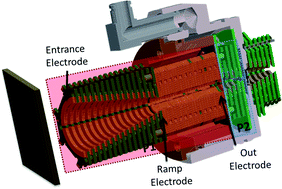Ion dynamics in a trapped ion mobility spectrometer†
Abstract
In the present paper, theoretical simulations and experimental observations are used to describe the ion dynamics in a trapped ion mobility spectrometer. In particular, the ion motion, ion transmission and mobility separation are discussed as a function of the bath gas velocity, radial confinement, analysis time and speed. Mobility analysis and calibration procedure are reported for the case of sphere-like molecules for positive and negative ion modes. Results showed that a maximal mobility resolution can be achieved by optimizing the gas velocity, radial confinement (RF amplitude) and ramp speed (voltage range and ramp time). The mobility resolution scales with the electric field and gas velocity and R = 100–250 can be routinely obtained at room temperature.


 Please wait while we load your content...
Please wait while we load your content...